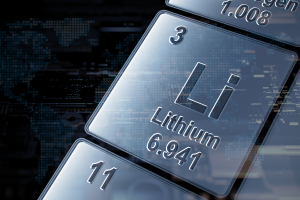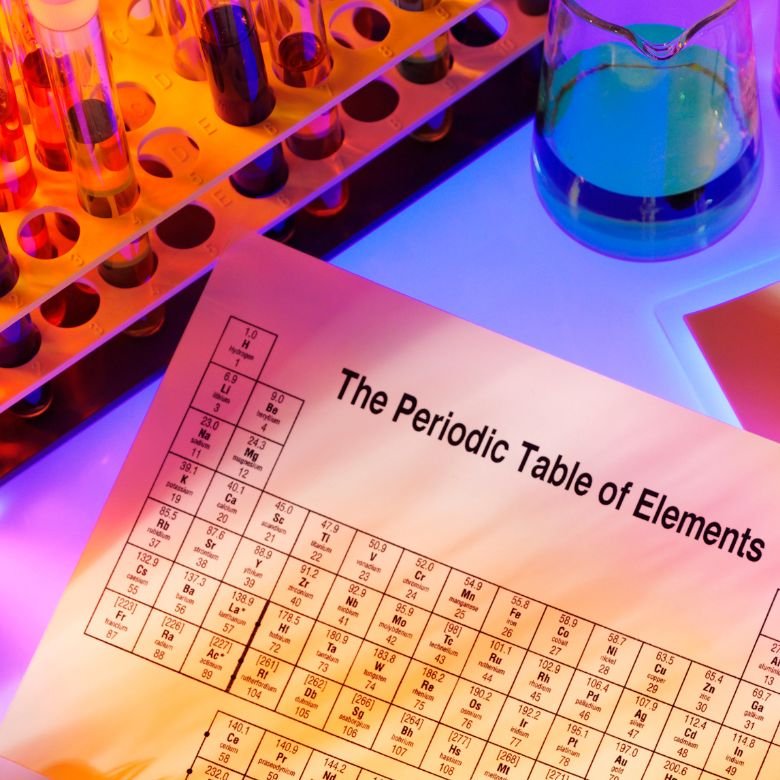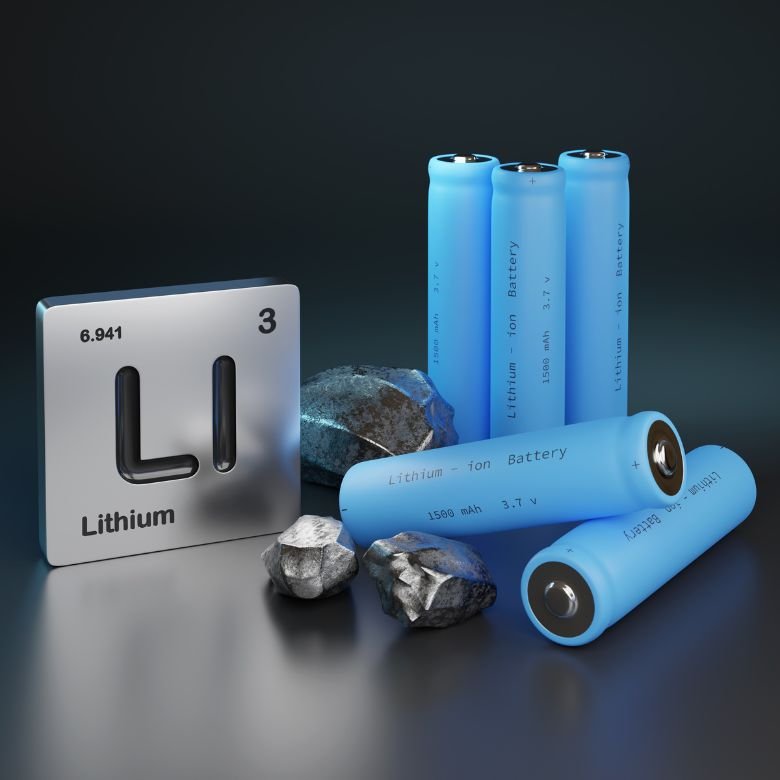Elements classified in group 1 of the periodic table, that is lithium (Li), sodium (Na), potassium (K), rubidium (Rb), caesium (Cs) and francium (Fr), are generally called lithium group elements. Given their strong metallic properties and the ability to form strong basic (alkaline) hydroxides, sometimes they are also referred to as alkali metals. What else do the lithium group elements stand out with and what compounds do they form? Read more in the article below!

Characteristics of alkali metals
The atoms of the lithium group elements contain only one electron on the valence shell in the basic state on the s orbital. Due to the low values of the first ionisation energy, which are:
- 3 [kJ·mol-1] for lithium,
- 8 [kJ·mol-1] for sodium,
- 8 [kJ·mol-1] for potassium,
- 0 [kJ·mol-1] for rubidium,
- 7 [kJ·mol-1] for caesium,
the valence electron is bound on the shell very weakly, being easy to detach. It is much more difficult for another element to draw off the next electron, which is located in the enclosed electron shell. This requires the energy input to be even several times higher. The second ionisation energies for the lithium group elements are as follows:
- 1 [kJ·mol-1] for lithium,
- 4 [kJ·mol-1] for sodium,
- 4 [kJ·mol-1] for potassium,
- 0 [kJ·mol-1] for rubidium,
- 0 [kJ·mol-1] for caesium.
This implies that alkali metals only form monovalent cations and never occur in higher oxidations states. Furthermore, the chemical compounds they form are almost exclusively ionic. In addition to the +I oxidation state being typical of these elements, there are a few compounds where sodium, potassium, rubidium and caesium occur in the –I oxidation state. The position of alkali metals in the periodic table, where they begin each period, suggests that they have the lowest nuclear charge. This implies that the attraction of their valence electrons as well as further electrons located on the enclosed shells is the weakest. They also have the longest atomic and ionic radii.
The low electronegativity values are caused by a low ionisation energy and a long atomic radius. Due to these characteristics, caesium and francium show the lowest electronegativity among all elements in the periodic table.
Alkali metals easily transform into an ionic state, which is because they easily give away electrons. This also directly translates into their strongly negative standard potentials. Lithium takes the first position in the electrochemical series, with a standard potential of -3.0401 V.
Coloured alkali metals
What is also interesting is the colouring of flames by the lithium group elements. Their free atoms, appearing as a result of heating up their volatile compounds, are very prone to excitation. Then they become the source of radiation due to giving away excess energy, and their spectrum, just as the spectra of the calcium group elements, are partially situated in the range of visible light. Therefore, in qualitative analysis, alkali metals are examined by the flame test and, respectively:
- lithium colours the flame carmine,
- sodium colours the flame yellow,
- potassium, rubidium and caesium colour the flame violet and pink.
The physico-chemical properties of alkali metals
All elements from group 1 of the periodic table have a metallic nature and a white-and-silver colour. Their surfaces show metallic gloss, but normally tarnish very quickly, getting covered by oxides.
The hardness of alkali metals declines from lithium to caesium, but each of them is soft enough to be cut easily with a knife. The melting point also varies within the same series, ranging from 453.7 K for lithium to 306.1 K for caesium.
Lithium has the lowest density, and the density of lithium, sodium and potassium is lower than that of water. Each alkali metal conducts electric current, and sodium shows, at room temperature, a conductivity only three times lower than silver, which has the lowest specific resistance.
Unlike most metals, the lithium group elements show relatively low boiling points. Most of them (except lithium), boil below 1300 K. Alkali metals transformed into the gaseous state take the form of monoatomic molecules.

The reactivity of alkali metals
The chemical reactivity of alkali metals is quite high and grows from lithium to caesium. Lithium reacts with oxygen only when the temperature is increased to around 370 K, so in normal conditions lithium does not lose its metallic gloss. At room temperature, all the other alkali metals quickly react with oxygen and lose their gloss. Thus, they are normally stored under kerosene. Burning alkali metals in the air also gives varied effects: lithium burns out to an oxide, sodium to a peroxide, and potassium, rubidium and caesium form superoxides.
A reaction characteristic of alkali metals is the commonly observed throwing of a piece of metal into water. This reaction occurs abruptly and its process is increasingly spectacular from lithium to caesium. The heat emitted when we perform it with sodium is enough to burn it out. Potassium ignites just after touching water, while rubidium and caesium cause explosions. Caesium, being the most reactive lithium group element, self-ignites already upon contact with air. In terms of some of its properties, lithium resembles an element from the second group in the periodic table: magnesium. Unlike other alkali metals, but similarly to magnesium, it produces a sparingly soluble carbonate and phosphate.
The compounds of lithium group elements
The compounds that can be formed by alkali metals are classified into the following groups:
- MH-type hydrides of alkali metals, which are produced by a direct reaction between hydrogen and metals at elevated temperatures.
- The compounds of alkali metals with oxygen, which are a bit more complex. As mentioned above, only lithium oxide is formed by burning a metallic element in the air. Others burn out upon the formation of higher oxides, which can be reduced with an appropriate metal at an elevated temperature.
- The compounds of alkali metals with halogens are mostly ionic compounds with a crystal structure. A large part of alkali metal halides have a space lattice similar to sodium chloride, whereas CsCl, CsBr and CsI form a lattice like caesium chloride.
- Alkali metal hydroxides are colourless solids with strong hygroscopic properties. They are ionic compounds and their dissolving in water is heavily exothermic.
- Their compounds with sulphur occur in three types: MHS hydrogen sulphides, M2S sulphides and MSn polysulphides, where n ranges from 2 to 6.
- Alkali metals also produce oxyacid salts such as nitrates, carbonates and sulphates of alkali metals, as well as a separate group of ammonium salts.
An interesting fact about the salts of alkali metals is that if the anion also has no colour, the salts are colourless and often freely soluble in water. In aqueous solutions, their cations are subject to hydratation with a force that increases from caesium to lithium. Nearly all lithium salts contain crystalline water. Many of them are additionally hydrated, unlike potassium salts. Rubidium and caesium salts are always anhydrous.
The natural occurrence of alkali metals
The distribution of alkali metals in nature is varied. The Earth’s crust contains extremely high amounts of sodium (2.83%) and potassium (2.59%) as well as small amounts of lithium (2.0·10-3%), rubidium (9·10-3%) and caesium (3·10-3%). Francium occurs naturally only in negligible amounts in the form of an unstable radioactive isotope, an actinium breakdown product.
Lithium occurs in the Earth’s crust normally as lithium-sodium-potassium beds such as aluminosilicates, e.g. spodumene LiAl[Si2O6] and lepidolite KLi2Al[(F,OH)2Si4O10], and as phosphates, e.g. amblygonite LiAl[(PO4)(F,OH)]. Minerals containing sodium include the most common albite Na[AlSi3O8] and its solid solutions with potassium and calcium aluminosilicates.
Extremely rich deposits, distributed virtually all over the world, are also formed by such sodium compounds as sodium chloride (rock-salt) and sodium nitrate, called Chile saltpetre.
Huge amounts of sodium canalso be found in salty water: seas and oceans. It is estimated that sodium chloride represents even 2.8% of ocean water. Comparing the sodium and potassium contained in Earth’s crust, despite their similar quantities, potassium is distributed in a completely different way, as its compounds very sparsely form deposits.
The most commonly found are potassium-based minerals occurring over the upper layers of rock-salt beds. These include: sylvine KCl, carnallite KMgCl3·6H2O and kainite KMgCl(SO4)·3H2O. This chemical element also occurs in the form of aluminosilicates such as potassium feldspar K[AlSi3O8] and mica KAl2[AlSi3O10(F,OH)2]. Potassium compounds that are produced during the breakdown of these minerals are very easily soluble in water. In consequence, as they are formed, a large part of them is absorbed by the soil due to weather conditions and only a small amount is transferred to seas and oceans together with the flowing water. This is why the quantity of potassium existing in salty water is around 40 times lower than the content of sodium.
As the presence of potassium present in the soil is required for the proper growth of plants, their ash contains considerable amounts of potassium carbonate while being rather poor in sodium compounds.
The natural presence of rubidium and caesium is low; they are only found accompanied by other alkali metals. Francium occurs mainly as radioactive isotopes formed as:
- a product of 235U uranium breakdown,
- a product of 227Ac actinium breakdown.
We can also find 40K potassium and 87Rb rubidium in the form of radioactive isotopes.

Applications of alkali metals
Metallic lithium is often used as an additive improving the stability and strength of aluminium, zinc and magnesium alloys. It is also applied as a deoxidant in copper metallurgy and as a component in Li/FeSx electric batteries. As lithium stearate, it provides appropriate density of lubricants. Its lubricating characteristics are stable at temperatures from 250 to 420 K. Lithium carbonate is used for the production of porcelain and glaze in the form of flux.
Sodium is a very important material used to acquire many products of daily use, such as the whitening sodium peroxide, amide, and sodium cyanide. In laboratories, sodium is applied on a smaller scale due to the reducing properties to many organic compounds. Another important application of sodium is using it as a constituent in the lead alloy used for producing the antiknock agents added to petrol. Metallic sodium is also used in sodium-vapour lamps due to the characteristic yellow light that we can observe when exciting it. Nuclear reactors contain liquid sodium and a liquid sodium-potassium alloy that are there to cool down the whole system.
The electrons of metallic caesium are subject to the photoelectric effect, so they can easily be detected with the use of light. This is why caesium is used for building caesium-based photocells that contain an alloy of caesium with aluminium and barium.
